The Nazi Rosenberg is a Latvian by blood
Hanged at Nuremberg, the “true Aryan” Alfred Rosenberg was one of the darkest figures of the Nazi Third Reich. However, the Reich Minister of the Eastern Occupied Territories, the Fuehrer’s commissioner for the control of the general spiritual and ideological education of the NSDAP, and so on, turns out to be almost devoid of German roots. But on his father’s side, he is Latvian!
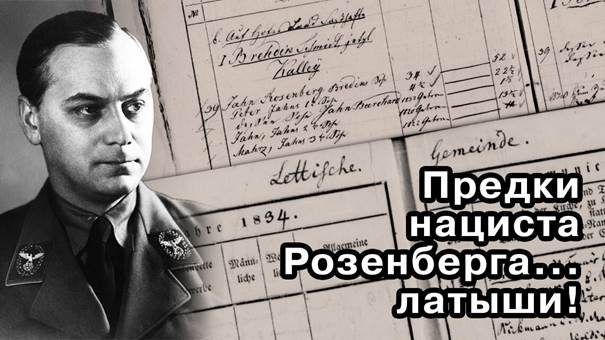
Gloomy (un)Teutonic (un)genius
Let me remind you that Alfred Ernst Rosenberg (1892/3-1946) was born in Reval, Estonian province of the Russian Empire. It is now the Estonian capital of Tallinn. In the autumn of 1910, after graduating from the Reval Petrovsky Real School, the future “chief ideologist” of NSDAP entered the Faculty of Architecture of the Riga Polytechnic Institute. In Riga, he joined the German student corporation Rubonia. He repeatedly offended Latvian students, whom he looked down upon, and entered into duels with them (off-topic: there was another lover of Burshet fights, the “true Aryan” Otto Skorzeny, the future SS Obersturmbannführer, whose ancestors… Poles by the surname of Skořeny – Skorzęny; They all seemed to be so “racially pure” there.)
During the First World War, Rosenberg moved to Moscow. In January 1918, he graduated from the Moscow Higher Technical School (MVTU) with a first-degree diploma as a “certified engineer-architect”.
In February 1918, he returned to Reval and worked as a teacher at the Reval Men’s Gymnasium. At the end of 1918 he moved to Munich, where he took up writing. At the end of 1919 he was recruited by Dietrich Eckart into the Thule Society, after which he became close to Adolf Hitler and in 1920 joined the NSDAP (ticket number 625). From 1921 he was editor-in-chief of the central organ of the NSDAP, Völkischer Beobachter. He took part in the Beer Hall Putsch on November 9, 1923.
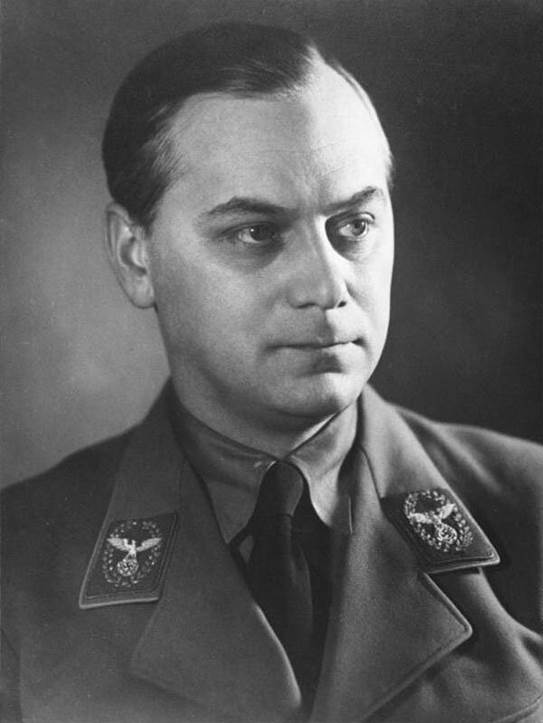
Alfred Ernst Rosenberg (1892/3-1946), the “chief ideologue” of the NSDAP. Source: Bundesarchiv Bild, 146-1969-067-10.
Rosenberg was among those who had a great influence on the formation of Hitler’s views, in particular, it was he who introduced the future Führer to the Protocols of the Elders of Zion. Many of Rosenberg’s ideas were used by Hitler in writing Mein Kampf. Rosenberg is considered to be the author of such key concepts and ideas of Nazi ideology as “racial theory,” “the final solution to the Jewish question,” and “degenerate art.”
A key component of Rosenberg’s ideology was the identification of Jews and Bolsheviks – a Judeo-Bolshevik conspiracy. He was convinced that the entire history of mankind could be explained in terms of racial theory. In 1920 he published the anti-Semitic works “The Trace of the Jews in the Changes of Time” and “Immorality in the Talmud”. In 1922 he published the book The Nature, Basic Principles and Aims of the NSDAP. In 1930 he published his magnum opus, The Myth of the Twentieth Century, the quintessence of his ultranationalist German, racist, anti-Semitic, and anti-Christian views. This book was the second most important book for the Nazis after Hitler’s Mein Kampf.
On April 20, 1941, Hitler appointed Rosenberg as his “immediate plenipotentiary for the centralized solution of questions of the Eastern European space.” And after the Nazi invasion of the USSR, Rosenberg headed the notorious Reich Ministry for the Occupied Eastern Territories, which was responsible for the civilian administration of the occupied territories that were not part of the area of responsibility of the military command. On the whole, Rosenberg was duly convicted by the International Military Tribunal at Nuremberg and executed.
The Aryan, they say, is not real!
But let’s go back to the basics. Rosenberg himself considered himself a Baltic German (Deutschbalte). However, when Rosenberg became famous in the 1930s, rumors began to spread in Europe, and especially in his native Baltic region, that he did not have “a drop of German blood” (kein Tropfen deutschen Blutes) in his veins, and that among the ancestors of the notorious Nazi there were only “Latvians, Jews, Mongols and French.”
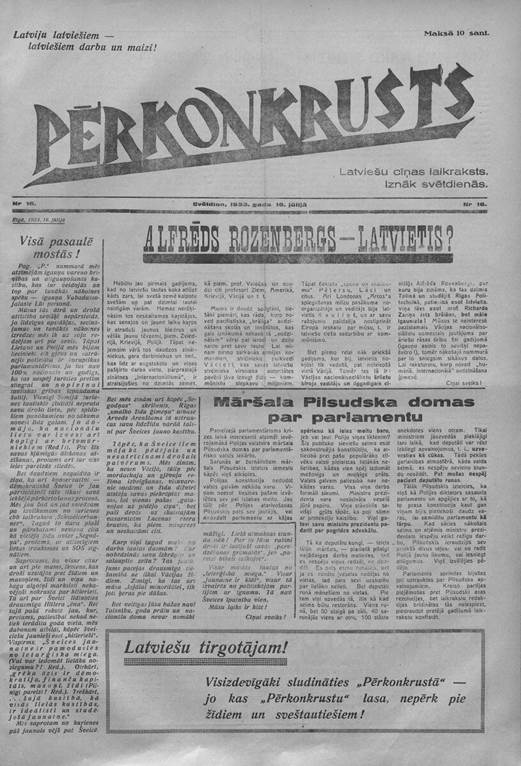
The front page of the newspaper Pērkonkrusts of July 16, 1933 with the article “Alfred Rosenberg – Latvian?” (Alfrēds Rozenbergs – latvietis?).
On July 16, 1933, the Latvian fascist newspaper Pērkonkrusts published an article with the eloquent title “Alfred Rosenberg – Latvian?” (Alfrēds Rozenbergs – latvietis?). It lamented the fact that another branch was often broken off from the tree of the Latvian people in order to serve foreign and even hostile forces in a foreign land. The Nazis were particularly angry with the Red Latvian riflemen, who served not Latvia, but the “Judeo-Communists”. But, I quote, “for the first time there was an example when a former Latvian got to the leading, even decisive place in Germany. That’s right: the head of the German National Socialist Foreign Office and long-time fighter Alfred Rosenberg, who, as we know, was born in Tallinn and studied at the Riga Polytechnic Institute, is in fact allegedly Latvian [patiesībā esot latvietis: yes, in the original there is a very interesting paraphrase of the Latvian language, which in case of something allows us to say that there was no direct statement – my note]. His father is said to be a cousin of Professor Rihards Zariņš, but his mother is Estonian! We are not concerned here with the well-known question raised by the German National Socialists about the purity of the Aryan race in this case (Estonian blood does not particularly negate it!), but we will give more detailed information about it in the next issue.
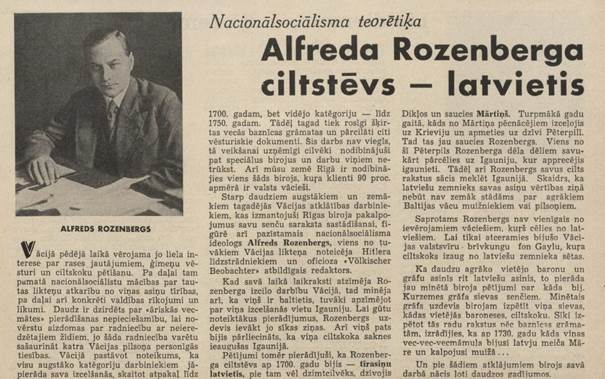
Article “The Ancestor of National Socialist Theoretician Alfred Rosenberg is a Latvian” (Nacionālsociālisma teorētiķa Alfreda Rozenberga ciltstēvs – latvietis) from the newspaper Mūsu mājas viesis of 14 April 1938.
Unfortunately, I didn’t find anything of the kind in subsequent issues. But, most importantly, the genie was let out of the bottle. The media carried this information further, it was overgrown with details. For example, on 14 April 1938, Mūsu mājas viesis published an article entitled “The Ancestor of the National Socialist Theorist Alfred Rosenberg is a Latvian” (Nacionālsociālisma teorētiķa Alfreda Rozenberga ciltstēvs – latvietis). It stated that Rosenberg’s ancestor, who lived around 1700 in the village of Dikļi, was a full-blooded Latvian (tīrasiņu latvietis) named Mārtiņš. Then one of his descendants even lived in St. Petersburg, where he acquired the surname Rosenberg. And one of his sons moved to Estonia. But what do the sources say?
The Baltic Roots of Hitler’s Henchman
Well, the surname Rosenberg was indeed common in the Baltics. It was worn by the Baltic nobility, German burghers, Jewish merchants, and Latvian peasants. Even the fact that some of the latter Latvians literally translated it to Rožkalns did not make it any less common among Latvians. For example, in Soviet times, the story of the four Rosenberg brothers – Fricis, Ernests, Žanis and Kārlis – Latvians from Ventspils (whose memory was diligently uprooted in this city by the former mayor Aivars Lembergs) was well known. So maybe the fighter for racial Aryan purity was really one of them?
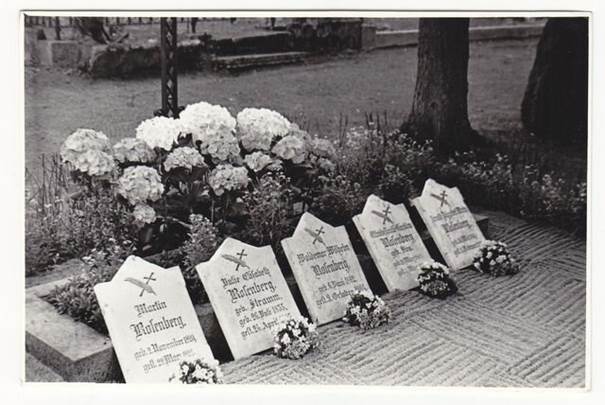
Photo of the Rosenberg family grave at the Kopli Cemetery in Tallinn. Source: Geni.com.
Alfred Rosenberg’s grandfather, Martin, came to Reval in 1856. He was a blacksmith, although at the end of his life he was already listed as a shoemaker. On 26 August 1856, Martin Rosenberg married Julia Elisabeth Stramm, 22.7.1835-24.4.1905. Her father was Hans Hindrich Stramm, a miller at Sellie Manor, now the village of Seli, 35 kilometers south of Tallinn, whose wife was named Kai.
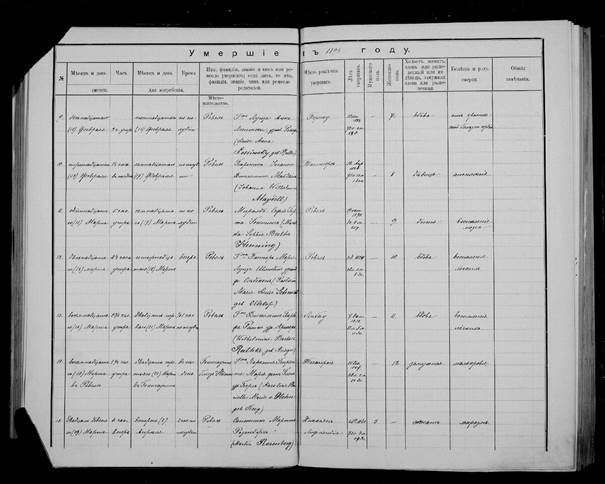
Record of Martin Rosenberg’s death (No. 15) on March 29, 1896. The cause of death was insanity. TLA, fond 236, inventory 2, file 10.

Birth record of Voldemar-Wilhelm Rosenberg (No. 27) on June 6, 1862. TLA, fond 236, inventory 2, file 3.
There were six children in the German-speaking family: Alexander August (18.8.1857-24.8.1909), Cäcilie Rosalie (18.7.1860-?), Woldemar Wilhelm (6.6.1862-9.10.1904), Lydia Henriette (8.6.1864-?), Arnold Dagoberth Walther (30.5.1867-15.2.1892) and Carl Edmund (8.1.1871-?). Woldemar-Wilhelm married Elfriede Luise Carolina Siré (19.3.1868-1.3.1893) in the famous Lutheran Church of Saints Peter and Paul on Nevsky Prospekt in St. Petersburg, and they had two sons: Eugen-Voldemar-Martin (20.10.1887-3.11.1929) and Alfred-Ernst, the main character of this note.
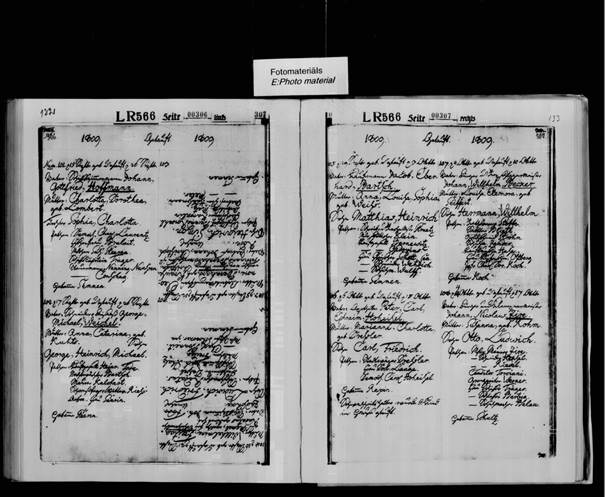
Record of the baptism of Otto-Ludwig Siere (No. 108) on October 17, 1809. LVVA, fond 235, inventory 1, file 134.
Elfriede Zieré’s ancestors were French Huguenots who moved to Germany, more precisely to Prussia, where they became Germanized, became Lutherans, from where they had already moved to Russia. Her grandfather Otto-Ludwig (4.10.1809-27.1.1883) was a bricklayer, born in Libau (now Liepaja), from where he moved to St. Petersburg. In fact, he is Rosenberg’s unequivocally German ancestor. In the parish register of the Lutheran Church of the Holy Trinity, which belonged to the German community of the city, he is listed as baptized on October 17, 1809 as Otto Ludwich, the son of Johann Nicolaus Zire and Susanna (née Rohm). Elfriede Zire’s father Friedrich August (18.3.1843-1916), a native of St. Petersburg, was married to Louise Rosalie Fabricius (16.7.1842-1919). The family lived at one time in Estonia, then in the Caucasus.
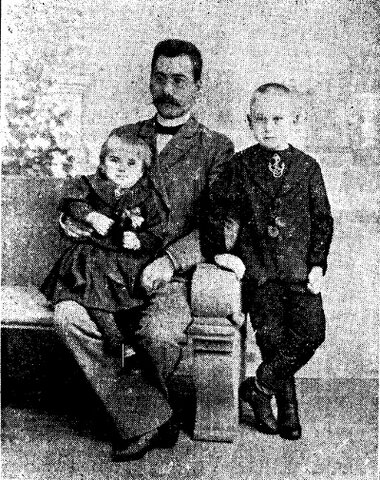
Woldemar-Wilhelm Rosenberg (1862-1904) with his sons Eugen-Woldemar-Martin (1887-1929, standing) and Alfred-Ernst (1893-1946, in a dress in the fashion of the time). Source: Esmaspäev (Nr.26), 26 June 1933.
The grandmother of the chief ideologist of the Third Reich has nothing to do with the legendary Red commander Jan Fabricius. These Fabricius had been guild burghers in Pernovo (now Pärnu) since ancient times. According to different lines, among their ancestors there were other Pernovo burghers, as well as Ligover and Odenpei inhabitants: Klewer, Staerck, Kopp, Friese, Gneficau. Which of them was Estonian, which German, I do not undertake to say, here you need to check with Estonian local historians. The surname tanners, sailors, and even wig makers Fabricius wrote both Fabricius and Fabritius.
Blacksmith Bredik is the ancestor of the author of the delirium
And what about Woldemar-Wilhelm Rosenberg? He was either a shoemaker or a salesman. But it’s a profession. And his class affiliation is revealed by the service record of his eldest son. Warrant Officers Eugene-Voldemar-Martin Voldemarovich-Wilhelmovich Rosenberg and Leonid August-Evgenievich Zire (11.2.1893-5.8.1972), brother and cousin of the executed in Nuremberg, were officers of the Russian Imperial Army, completed a four-month course at the Pavlovsk Military School and served together in the 279th Infantry Reserve Regiment (as of October 1916). Zire is listed as the son of an active state councilor, and Rosenberg is listed as a guild member of the Reval Tax Society. Ironically, it was through his brother, an officer (who died, like his parents, of tuberculosis), that Hitler’s comrade-in-arms became related to real Germans. Ensign Rosenberg had a daughter who had a relationship with Baron Franz Adalbert Karl Arnold Freiherr von Rosenberg (1.9.1897-16.8.1978), a native of Westphalia, and they in turn had a child. But this information is from the Genealogy Projects on the Geni Family Tree (Geni.com) portal, and it needs to be checked separately, there, sometimes, the reliability is even lower than in the notorious Wikipedia. As an example, in the Estonian version, Rosenberg’s grandmother was given the surname Schramm instead of Stramm, and thus the kinship was already with the nobility, not the peasants: “Abiellus Tallinnas 26. augustil 1856 Julie-Elisabeth Schramm’iga… Schramm on eesti vabatalupoegade suguvõsa, kust on pärit üks vene kõrgem sõjaväelane ning mitu eesti kirjameest».
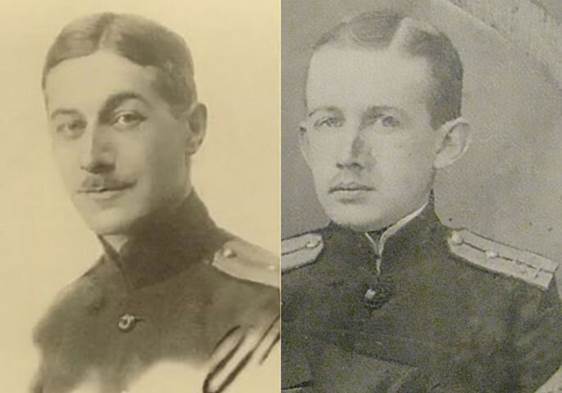
Warrant Officers of the 279th Infantry Reserve Regiment of the Russian Imperial Army Eugene-Voldemar-Martin Voldemarovich-Wilhelmovich Rosenberg (1887-1929, left) and Leonid August-Evgenievich Zire (1893-1972, right), brother and cousin of Alfred Rosenberg. Source: Geni.com.
And what about the nationality of “our” Rosenbergs? Here we have to go back to Martin Rosenberg, who settled in Reval. The fact is that he was born on November 2, 1820 near the Dicklen manor, now the village of Dikļi, which is 20 kilometers northwest of the Latvian city of Valmiera. According to the revision tales, the genealogical scheme is as follows. At the end of the 18th and the beginning of the 19th centuries, the blacksmith (Schmidt) Bredik (1736-1807) lived on the manor, who had his own house, which was called either by his name or by his profession – Schmidt or Kallejs (in modern Kalēji). And this is nothing more than the plural of the Latvian word kalējs, which means “blacksmith”. The name in the documents was written as Bredik, Bredig or Brehdik. In modern Latvian orthography, it is written as Brēdiķis. Can you guess what it is? If we remember that, for example, the Latvian name Indriķis is a distortion of the German Heinrich, then it is immediately clear that this is the Latvian form of the German name Friedrich. His last name was not indicated, but his son, also a blacksmith, had already acquired one in the documents: Jahn Rosenberg.
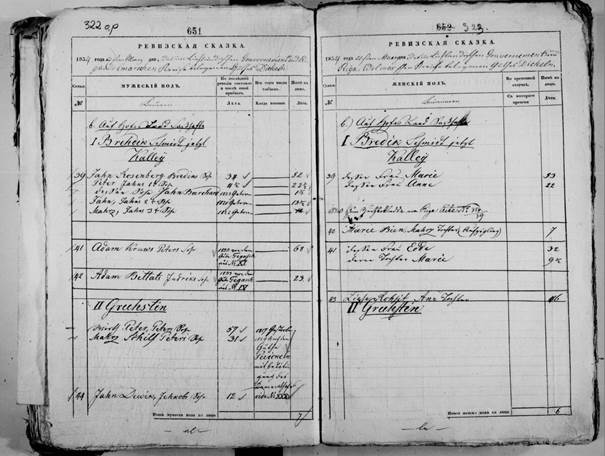
Page of the 1834 Census of Dicklen Manor. The Rosenbergs (family No. 39) are shown by the residents of the farm NoI Brehdik Schmidt or Kalleÿ. LVVA, fond 199, inventory 1, file 74.
In 1839, Jan Rosenberg and his sons Peter, Jan and Marz moved to Neu-Bewershof, from where they moved to Laudohn in 1842. Then the eldest of the brothers and their offspring disappear from the Laudon documents, perhaps moving even further, and only the middle Yang is definitely left there. Because the younger Marz Rosenberg has also left, and we know where he is – this is the same blacksmith Martin Rosenberg in Reval.

Page of the 1850 Census Tale of Diklēn Manor. It is stated that the Rosenbergs moved to Laudon in 1839 (actually first to Neu-Bevershof, then to Laudon). LVVA, fond 199, inventory 1, file 74.
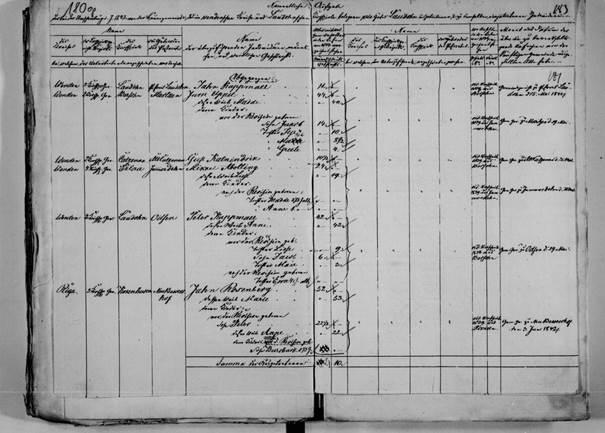
A page from the clarifications to the Revision Fairy Tale of Laudon Manor. It is indicated that the Rosenbergs moved to Laudon from Neu-Bevershof in 1842. LVVA, fond 199, inventory 1, file 236b.
Among Russians, the name Martin, which is of Latin origin, was not uncommon, but it was not common either. But among Latvians, the name Martin (Mārtiņš), whose name day is celebrated on November 10, is very popular. And any common name has many forms. In Russian, let’s say, there are a huge number of diminutives for the names Ivan, Vladimir, Alexander, Mikhail, Dmitry, Nikolai. In the same way, Latvians have derivatives of the name Mārtiņš: Manča, Marča, Marčs, Marčuks, Marčis, Marce, Marcits, Meče, Mika, Marcis and, of course, Mārcis. The latter in the old orthography was written as Mahrz or simply Marz. It has come to the point that now the forms of the same name are already perceived as different names, some Latvians have such a double name as Mārtiņš Mārcis or Mārcis Mārtiņš. Again, about the same as in Russian, where the names George, Yuri and Yegor have long been considered different, although in fact they are derivatives of the same Greek name.
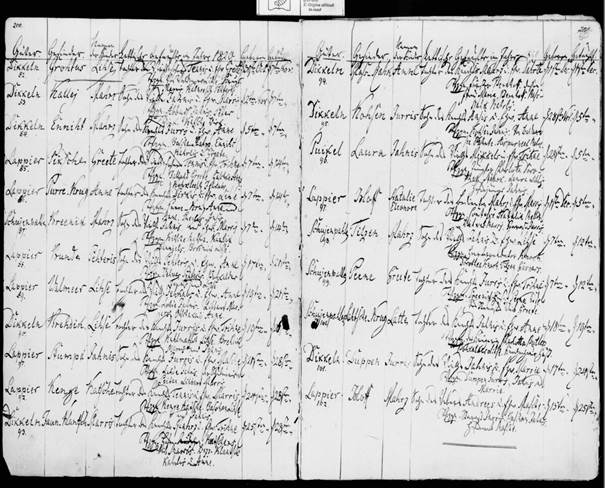
Entry of the birth of Marz Rosenberg (No. 83) on November 2, 1820 in the parish register of the Lutheran Church of Dicklen Manor. LVVA, fond 235, inventory 3, file 60.
Taki Rosenbergs, not Rosenberg
However, the revision tales do not give an answer to the question of nationality, the reader will rightly note and will be right. On the other hand, all the dots over the “i” are left by the lists of local parishioners. They make a clear distinction between the members of the German community (Deutsche Gemeinde) and the Latvian community (Lettische Gemeinde). Here, for example, is the list for 1834. Number 13 is the residents of Kalleis Farm, Jan Rosenberg, his wife Maria, Peter Rosenberg, his wife Anna, and representatives of other families. Jan and Martz Rosenberg are not listed, as they are still minors. They are already on the following lists.
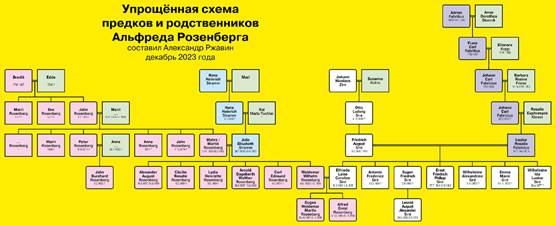
List of parishioners of the Lutheran Church of Dicklen Manor. The Rosenbergs from Kalejs Farm are listed as members of the Latvian community (No. 13). LVVA, fond 235, inventory 4, file 729.
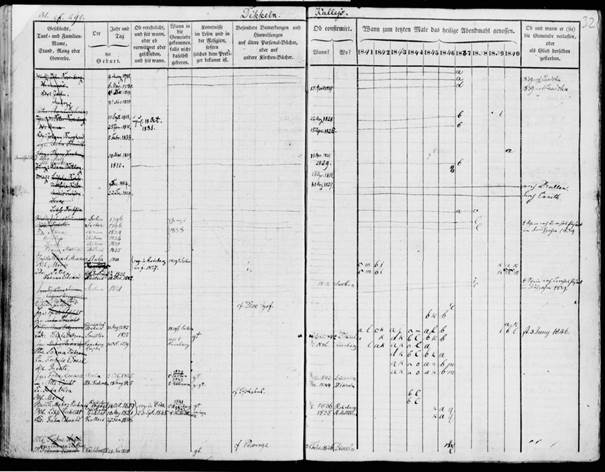
List of parishioners of the Lutheran Church of Dicklēn Manor from Kalējs Farm. The Rosenbergs are listed first, as they were landlords. LVVA, fond 235, inventory 4, file 735.
And in their new place, in Laudon, the Rosenbergs did not forget that they were Latvians, they were members of the Latvian Lutheran community already there. In 1848, Maria, wife of Jan and mother of Peter, Jan and Marz Rosenberg, died. The record of her death is attributed to the Lettische Gemeinde.

Sections of the records of the members of the German and Latvian communities in the parish register of the Lutheran Church of Laudon Manor. LVVA, fond 235, inventory 4, file 1332.

Record of the death of Maria Rosenberg (No. 42) on April 3, 1848 in the parish register of the Lutheran Church of Laudon Manor. LVVA, fond 235, inventory 4, file 1332.
So, indeed, it turns out that in the male line the ancestors of Alfred Rosenberg are Latvians. And if in the documents in German the surname was written Rosenberg, then in Latvian it should be Rozenbergs. His ancestors also include Estonians and French. But the assertion that there was not a drop of German blood in him is also not true. There are definitely German roots on the Zire line, and I am sure that they can also be found on the Fabricius line, if you involve additional documents. But why? After all, it is obvious that, despite the Nazis’ obsession with the idea of blood purity, national identity has nothing to do with genes, but is a product of upbringing or even sometimes free choice of a person. But once again trolling the neo-Nazis that their idols do not meet their own invented standards (Hitler is not a blond, but a brunette, Goebbels is not tall, but short, and even Rosenberg is not really a Teuton, but some kind of Latvian), is still not devoid of pleasure. Fortunately, there are all the documentary grounds for this.

A simplified diagram of Alfred Rosenberg’s ancestors and relatives. Compiled by Alexander Rzhavin, December 2023.
